Given a data frame like :
df1= data.frame(x = c(1:50))
df1$val=df1$x*(-0.35)
I used the ggplot2 and added a regression line with the command
t=ggplot(df1, aes(x=val, y=x))+geom_smooth(method=lm) + geom_point()
In order to add the equation and the r value I tried the code from this question Adding Regression Line Equation and R2 on graph
but I am getting the error
Error in terms.formula(formula, data = data) :
'data' argument is of the wrong type
Any ideas on how to fix this?
EDIT
The code I used
my_sts <- function(df1){
m <- lm(df1$x ~ df1$val, df1);
eq <- substitute(italic(y) == a + b %.% italic(x)*","~~italic(r)^2~"="~r2,
list(a = format(coef(m)[1], digits = 2),
b = format(coef(m)[2], digits = 2),
r2 = format(summary(m)$r.squared, digits = 3)))
as.character(as.expression(eq));
}
tgen = t + geom_text(x = -10, y = 50, label = eq(df1), parse = TRUE)
